
How to Migrate to Google Analytics 4 (Step by Step)
Important Note: On July 1, 2023, your Universal Analytics property will no longer be able to process data. To ensure that you can continue tracking and measuring your digital properties, switching to Google Analytics 4 before this date is essential.
Do you want to know how to migrate to Google Analytics 4? In this article, we’ll show you step by step how you can migrate from Universal Analytics to Google Analytics 4 (GA4).
We all know that Google has introduced a new version of Google Analytics called Google Analytics 4 (GA4) with new exciting features, and Google is pushing all of us to move to GA4.
Most of us have custom tracking on our websites using Universal Analytics; even popular WordPress Google Analytics plugins do not support the GA4 properties.
You can connect a GA4 property to your existing Universal Analytics property and track your website traffic stats in both GA4 and Universal Analytics properties. Once Google releases GA4 fully, it will be easier to upgrade as your old analytics data will remain there.
Table of Contents
What is Google Analytics 4?
Google Analytics 4 is the next-generation measurement solution from Google, designed to help digital businesses make better decisions about their marketing strategies. It offers reports and insights that are more accurate and reliable than the data from Universal Analytics.
With Google Analytics 4, you get access to the latest features and advancements in analytics technology to help you deliver better customer experiences and optimize your marketing campaigns. This new platform allows you to collect data from multiple devices and platforms, giving you a more comprehensive view of user activity.
Moreover, you can also track events and conversions more accurately, enabling you to measure the success of your marketing campaigns. Google Analytics 4 is the perfect solution for digital businesses looking to stay ahead in the ever-changing digital landscape.
Following are the remaining three versions of Google Analytics:
- Classic Google Analytics: This is the original version of Google Analytics, released in 2005. It utilizes a single tracking code and allows you to track website traffic using page tagging techniques.
- Universal Analytics: This is the next generation of Google Analytics, released in 2012. It utilizes the same tracking code but allows you to track website traffic on multiple devices and platforms.
- Google Tag Manager: This version of Google Analytics was released in 2012. It allows users to manage various tags related to Google Analytics. It easily adds and updates analytics tags without editing website code.
Note: Universal Analytics standard properties will stop processing data on July 1, 2023. (Google)
Before jumping into Google Analytics migration, you should check out Analytify – the best Google Analytics plugin for WordPress. Analytify allows you to present the statistics from Google Analytics attractively and helpfully. The integration is super simple and does not require the help of a developer to set up the integration. Once you integrate Google Analytics in WordPress using Analytify, you can view the dashboard both at the front and back end.
Google Analytics 4 vs Universal Analytics
If you’re looking to migrate from Universal Analytics to Google Analytics 4, it’s important to understand the major differences between the two. GA4 comes with a host of new features that businesses find attractive, but the biggest change is that it places more emphasis on event tracking than Universal Analytics.
So, what does this mean for website owners and sellers? GA4 provides a more user-centric view of data, enabling you to gain insights into how people use your website. You can learn more about user behavior by tracking specific events, such as clicks on buttons, form submissions, or video plays. This information can help you adjust your plans and improve the user experience on your website.
Click here to view a more detailed comparison between Google Analytics 4 and Universal Analytics.
How to Migrate to Google Analytics 4 (Step by Step)
Now that you know about all the versions of Google Analytics, it’s time to migrate to Google Analytics 4. Its latest features and advancements make it the perfect tool to help you take your digital business to the next level.
The process of migration is quite straightforward. All you need to do is create a GA4 property and connect it with your existing Universal Analytics property. This lets you track your website traffic stats in GA4 and Universal Analytics properties.
Once Google releases GA4 fully, it will be easier for you to upgrade as your old analytics data will remain there.
As Google said, “Beginning in March 2023, if you haven’t already created a GA4 property, we’ll create one for you unless you opt-out. This new property will be based on the settings in your Universal Analytics property. If you have created a GA4 property, and that property is connected to a Universal Analytics property, we’ll copy over any configurations (e.g., goals, audiences, etc.) from your Universal Analytics property that you have not marked as complete in your GA4 property, unless you opt out.”
Google recommends manually migrating to the new GA4 property to ensure a smooth transition.
As Google said, “We strongly recommend you manually migrate your Universal Analytics settings to GA4 prior to auto-migration to ensure the quality of your data.”
When migrating from Universal Analytics to Google Analytics 4, following a few steps is important to ensure that the data is properly transferred.
Here’s a step-by-step guide on how to migrate from Universal Analytics to Google Analytics 4 (GA4):
Step 1: Login and Click the Admin Tab
Before upgrading from Universal Analytics to Google Analytics 4, log into your Universal Analytics property.
Next, click on the Admin tab at the bottom of your screen. For further ado, see the screenshot below:
Once you have clicked on the “Admin” tab, a new window will open containing three columns: Account, Property, and View.
In the middle column labeled “Property,” select “GA4 Setup Assistant”.
Step 2: Create a New Google Analytics 4 Property
Once you click the “GA4 Setup Assistant” option, you will have two options:
- Create a new GA4 property
- Connect to an existing one
If you already have a Universal Analytics property that you want to upgrade, it is recommended that you select the “Connect to an existing Universal Analytics Property” option.
However, if you want to create a brand-new property with the upgraded GA4 version, select the “Create a new GA4 property” option.
Let’s explore both options.
Option 1: Connect an Existing GA4 Property
Suppose you already have a Google Analytics 4 (GA4) property associated with the site you want to track. In that case, connecting your existing GA4 property is the easiest way to get up and running with advanced tracking. With a few simple steps, you can take advantage of the new tools and features available in GA4.
To connect your existing GA4 property to the site, you’ll need to select the existing property from the drop-down menu.
Next, click on “Connect Properties.”
Once you’ve successfully connected your property, you can take advantage of the new GA4 features.
Now you have successfully setup GA4. You can now check your data has been transferred to the new Google Analytics 4 property.
Option 2: Create a New GA4 Property
This option is the recommended setup for most businesses. This will create a new property in GA4 that you can configure as needed.
The setup assistant will:
- Create a new GA4 property. Your original Universal Analytics property will remain unchanged.
- Copy basic settings from your UA property. You can then configure additional settings in your GA4 property.
- Turn on enhanced measurement to measure interactions with your content. Ensure that no personally identifiable information will be sent to Google.
- Collect data in your new property using your existing site tag.
To do that, click on the Create and Continue buttons.
Now that the new GA4 property has been successfully created, there are a few more steps to take to get the most out of your new GA4 property.
Next, click the “Go to Your GA4 Property” button to access the property settings.
Once you have selected the GA4 Property, a new window will open with various options. In this window, click the Data Streams option in the Property column. This will include a list of all available data streams for your Google Analytics 4 property.
A new window will open, where you will find your Measurement ID. The Measurement ID is a unique identifier that tracks information within your GA4 property. The Measurement ID is a unique, alphanumeric code that helps Google Analytics identify and differentiate your property from other properties.
Just copy that ID.
Now go back to your Universal Analytics property from the Property column.
In the Universal Analytics property column, click on Tracking Info >> Tracking Code and click on the Connected Sites Tags.
Now in the Connected Site Tags window, simply paste the GA4 Property ID you have copied and click on the Connect option as shown below.
After a Successful connection, it will display like this.
Conclusion: How to Migrate to Google Analytics 4
Google Analytics 4 offers a range of powerful features that can help you better understand and analyze your website’s performance.
Following the steps outlined above, you can set up Google Analytics 4 quickly and easily. With GA4 in place, you can access more data to make informed decisions about your website and marketing efforts.
We hope you understand how to migrate to Google Analytics 4 (GA4) and set up your GA4 property. If you have any questions, please feel free to reach out!
Frequently Ask Questions
What is Google Analytics 4?
Google Analytics 4 (GA4) is the latest version of Google Analytics that provides a more advanced and customizable approach to tracking website traffic and user behavior.
Why should I migrate to GA4?
Migrating to GA4 provides a more accurate and comprehensive understanding of user behavior on your website and access to advanced features like machine learning-powered insights and cross-device tracking.
Can I use GA4 and Universal Analytics (UA) simultaneously?
Yes, it is possible to use both GA4 and UA simultaneously. However, it’s recommended to migrate fully to GA4 to take advantage of its advanced features.
How do I set up GA4?
To set up GA4, you must create a GA4 property in your Google Analytics account and install the GA4 tracking code on your website. You can then start tracking user behavior and events.
What is the difference between GA4 and UA tracking?
GA4 tracking provides more comprehensive user behavior tracking, including cross-device tracking, machine learning insights, and a more flexible event tracking system. UA tracking is more limited in its capabilities but still widely used and supported.
Do I need to update my website code to migrate to GA4?
You must update your website code to install the GA4 tracking code and properly track events and user behavior.
How long does it take to migrate to GA4?
The time it takes to migrate to GA4 depends on the complexity of your website and the amount of data you want to migrate. It can generally take a few days to a few weeks to complete the migration process.
Can I still access my historical data in UA after migrating to GA4?
You can still access your historical data in UA after migrating to GA4. However, any new data will be tracked exclusively in GA4.
Is GA4 free to use?
Yes, GA4 is free to use for all Google Analytics users. However, some advanced features may require a paid subscription.
That’s all for how to migrate from UA to GA4 if you have any comments, feel free to ask us via the comment section below.
You can also check out Analytify vs Jetpack Stats – Which One is Better? and How to Set Up Phone Call Tracking in Google Analytics.
Not using Analytify yet? What are you waiting for?


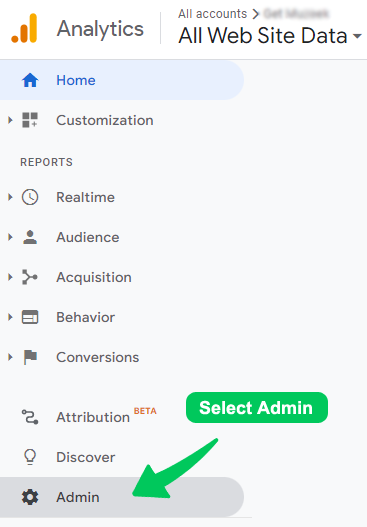

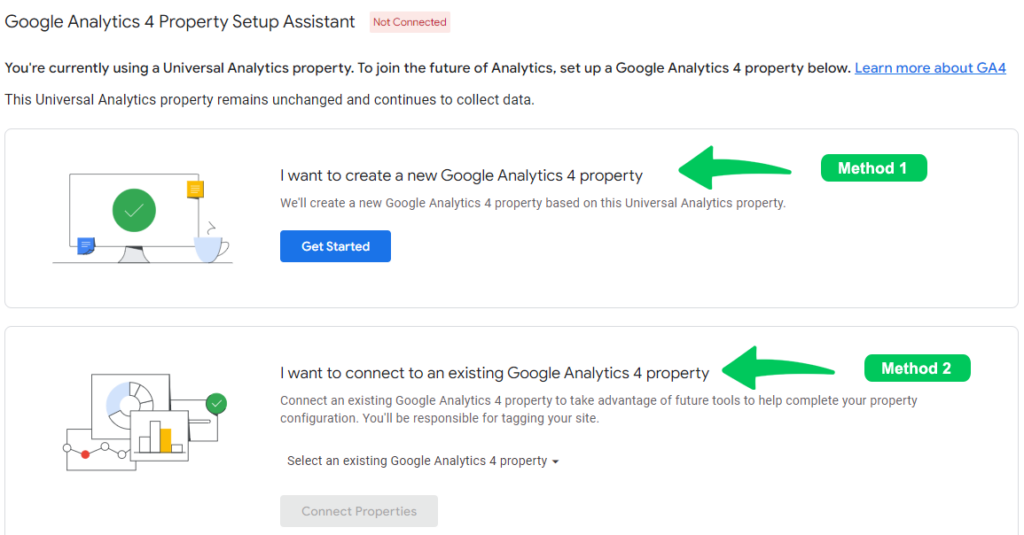

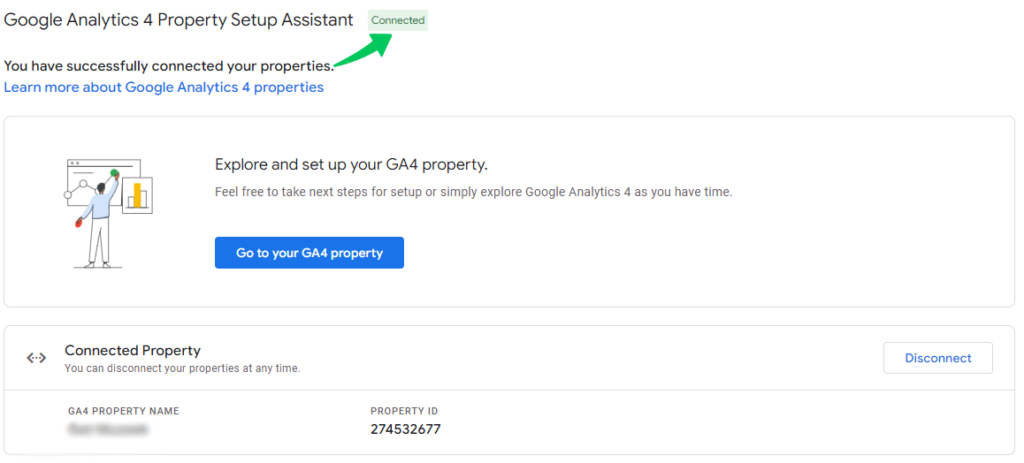





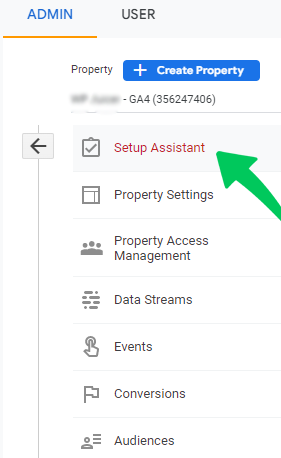

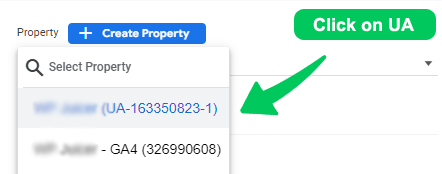







disregard, I figured out how to get the new accounts to show up
So we have to set it up this way because you guys still dont have a way for us to select the new GA4 account instead of the old UA? too complicated
I just followed these instructions exactly, and now I have no data at all anymore 🙁 I had UA, I set up a GA4 exactly as shown, I connected it in Analytics exactly as instructed here.
Now I have no UA, no GA4 data, nothing. I don’t know how to undo this. Please help.